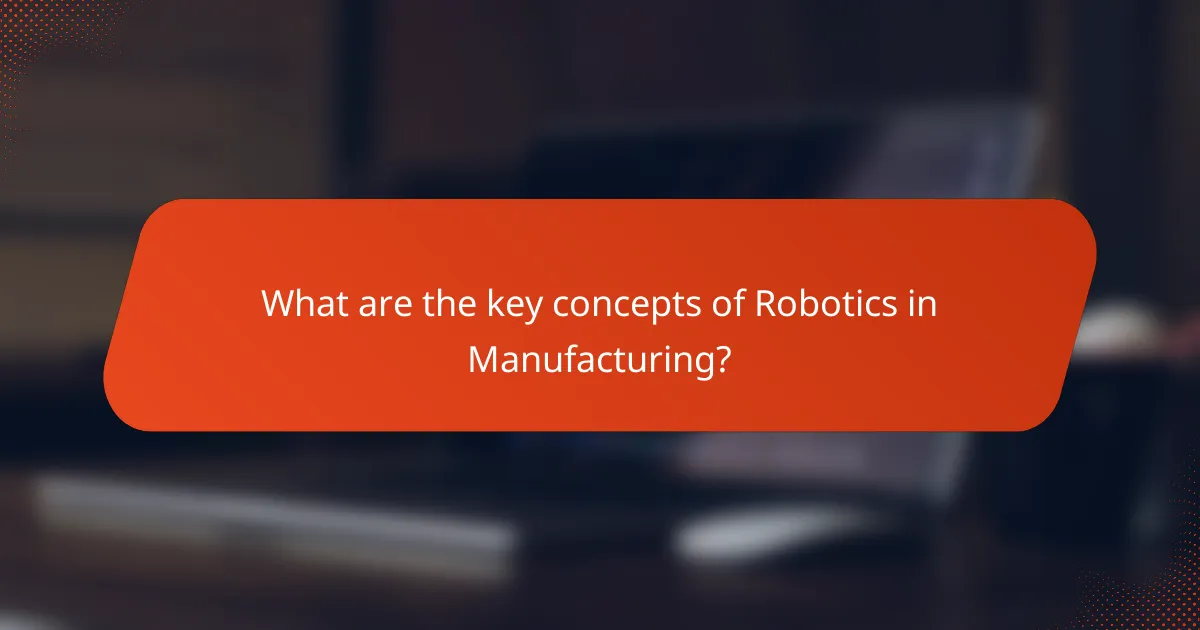Robotics in manufacturing encompasses key concepts such as automation, precision, and flexibility. Automation involves the deployment of robots to execute tasks independently, enhancing efficiency and reducing costs. Precision ensures high-quality production with minimal errors, as robots outperform humans in accuracy. Flexibility enables robots to adapt to various tasks and products, increasing responsiveness to market demands. Furthermore, the integration of artificial intelligence enhances decision-making, potentially boosting productivity by 0.8 to 1.4 percent annually, according to a McKinsey report. These elements collectively reshape manufacturing processes and influence workforce dynamics.

What are the key concepts of Robotics in Manufacturing?
Key concepts of robotics in manufacturing include automation, precision, and flexibility. Automation refers to the use of robots to perform tasks without human intervention. This leads to increased efficiency and reduced operational costs. Precision in robotics ensures high-quality production with minimal errors. Robots can operate with a degree of accuracy that surpasses human capabilities. Flexibility allows robots to adapt to different tasks and products. This adaptability enhances production lines’ responsiveness to market changes. Additionally, integration with artificial intelligence improves decision-making processes. According to a report by McKinsey, automation could raise productivity by 0.8 to 1.4 percent annually. These concepts collectively transform manufacturing processes and workforce dynamics.
How do robotics enhance efficiency in manufacturing processes?
Robotics enhance efficiency in manufacturing processes by automating repetitive tasks. This automation reduces human error and increases precision. Robotics can operate continuously without fatigue. They improve production speed, leading to higher output rates. For example, manufacturers using robotics report productivity increases of up to 30%. Robotics also optimize resource usage, reducing waste. Advanced robotics can adapt to different tasks quickly, further enhancing flexibility. Overall, these factors contribute to significant cost savings and improved competitiveness in the market.
What specific tasks can robots perform to increase production speed?
Robots can perform various tasks to increase production speed. They can automate repetitive assembly line operations. This reduces the time taken for tasks like welding, painting, and packaging. Robots can also handle materials quickly and efficiently. They excel in sorting, picking, and placing items with precision. Additionally, robots can operate continuously without fatigue. This leads to increased output over time. According to a study by McKinsey & Company, automation can boost productivity by up to 30% in manufacturing settings. This evidence supports the efficiency gains achieved through robot integration.
How do robots contribute to reducing operational costs?
Robots contribute to reducing operational costs by increasing efficiency and minimizing labor expenses. They perform repetitive tasks faster and with higher precision than humans. This leads to reduced cycle times and improved product quality. According to a study by McKinsey, automation can reduce operational costs by up to 30%. Robots also decrease the likelihood of human error, which can result in costly mistakes. Furthermore, they operate continuously without breaks, maximizing productivity. In manufacturing, implementing robots can lead to significant savings in labor costs, as fewer workers are needed for routine tasks. Overall, the integration of robots in manufacturing processes effectively lowers costs while enhancing output.
What are the current automation trends in manufacturing?
Current automation trends in manufacturing include increased use of robotics, artificial intelligence, and the Internet of Things (IoT). Robotics are being deployed for tasks such as assembly, welding, and packaging. AI enhances decision-making and predictive maintenance in production processes. IoT connects machines for real-time data analysis and improved efficiency. Collaborative robots, or cobots, work alongside human operators to boost productivity. Advanced automation systems enable greater customization and flexibility in manufacturing. The integration of automation technologies is projected to reduce operational costs by up to 30% by 2025. These trends indicate a shift toward smarter, more efficient manufacturing environments.
How is artificial intelligence integrated into manufacturing robotics?
Artificial intelligence is integrated into manufacturing robotics through advanced algorithms and machine learning techniques. These technologies enable robots to perform complex tasks with greater precision. AI allows for real-time data analysis, enhancing decision-making processes. Robots equipped with AI can adapt to changes in their environment. This adaptability leads to improved efficiency in production lines. AI-powered robots can also predict maintenance needs, reducing downtime. According to a report by McKinsey, AI integration can increase productivity by up to 40%. This demonstrates the significant impact of AI on manufacturing robotics.
What are the emerging technologies in robotics for manufacturing?
Emerging technologies in robotics for manufacturing include collaborative robots, artificial intelligence, and advanced sensors. Collaborative robots, or cobots, work alongside human operators to enhance productivity. Artificial intelligence enables robots to learn and adapt to new tasks. Advanced sensors improve precision and safety in manufacturing environments. These technologies are reshaping production processes and increasing efficiency. According to a report by McKinsey, automation could boost global productivity by up to 1.4% annually. This demonstrates the significant impact of these emerging technologies on manufacturing.
What impact does robotics have on the workforce in manufacturing?
Robotics significantly impacts the workforce in manufacturing by increasing efficiency and altering job roles. Automation through robotics enhances production speed and precision. This technology reduces the need for manual labor in repetitive tasks. As a result, some jobs may be displaced, particularly low-skill positions. According to a study by the McKinsey Global Institute, 60% of jobs in manufacturing could be automated. However, robotics also creates new roles requiring advanced skills in programming and maintenance. The demand for skilled workers in robotics and automation is rising. Overall, while robotics can lead to job displacement, it also fosters job creation in more specialized areas.
How does automation affect job roles and employment rates?
Automation significantly alters job roles and employment rates. It often leads to the displacement of certain jobs, particularly in repetitive and manual tasks. According to a McKinsey report, up to 800 million jobs could be affected by automation by 2030. However, automation also creates new job categories that require different skills. These new roles often focus on technology management, data analysis, and advanced manufacturing processes. The net effect on employment rates can vary by industry. In some sectors, automation may lead to job growth, while in others, it may result in a decline. Overall, the impact of automation on employment is complex and multifaceted.
What skills are becoming essential for workers in automated environments?
Essential skills for workers in automated environments include technical proficiency, problem-solving, and adaptability. Technical proficiency involves understanding and operating automated systems and software. Workers must be able to troubleshoot issues that arise during operations. Problem-solving skills are crucial for analyzing unexpected challenges and finding effective solutions. Adaptability is necessary as technology evolves rapidly in automated settings. Workers should continuously learn new tools and methods to stay relevant. According to a report by the World Economic Forum, 85 million jobs may be displaced by automation by 2025, highlighting the need for these skills. Therefore, developing these competencies is vital for future employment in automated environments.
How do robotics influence supply chain management?
Robotics significantly enhance supply chain management by improving efficiency and accuracy. Automated systems can handle tasks such as inventory management and order fulfillment. This reduces human error and increases speed in processing orders. According to a study by McKinsey, implementing robotics can boost productivity by 20% to 30%. Robotics also enable real-time tracking of goods, leading to better visibility in the supply chain. Furthermore, they can operate 24/7, ensuring continuous workflow without breaks. Overall, robotics streamline operations and reduce costs in supply chain management.
What role do robots play in inventory management and logistics?
Robots play a crucial role in inventory management and logistics by automating tasks such as sorting, picking, and transporting goods. They enhance efficiency by reducing human error and increasing speed in operations. For instance, autonomous mobile robots (AMRs) navigate warehouses to move products to designated locations. According to a report by McKinsey, automation can increase warehouse productivity by up to 25%. Additionally, robots can operate continuously without breaks, further optimizing workflow. Their integration with inventory management systems allows real-time tracking of stock levels. This capability improves accuracy in inventory counts and reduces overstock or stockouts. Overall, robots significantly streamline logistics processes, leading to cost savings and improved service levels.
How can robotics improve the accuracy of supply chain operations?
Robotics can significantly improve the accuracy of supply chain operations through automation and precision. Automated systems reduce human error in inventory management. Robotics can track inventory levels in real-time, ensuring data accuracy. They enhance order fulfillment by precisely picking and packing items. This minimizes discrepancies between ordered and delivered products. According to a study by McKinsey, companies using robotics improve accuracy rates by up to 99%. Robotics also streamline routing and scheduling, optimizing delivery processes. These advancements result in faster and more reliable supply chain operations.
What are the challenges associated with implementing robotics in manufacturing?
Implementing robotics in manufacturing faces several challenges. High initial costs can deter companies from adopting robotic systems. Integration with existing processes often requires significant adjustments. Workforce displacement is a concern, as automation can lead to job losses. Technical expertise is necessary for programming and maintenance, which may be lacking. Additionally, ensuring safety and compliance with regulations is crucial. Finally, managing the ongoing costs of upkeep and upgrades can be a financial burden. These challenges can hinder the widespread adoption of robotics in the manufacturing sector.
What are the common barriers to adopting robotics in manufacturing facilities?
Common barriers to adopting robotics in manufacturing facilities include high initial costs, lack of skilled workforce, and integration challenges. High initial costs can deter investment, with estimates showing that robotic systems can range from tens of thousands to millions of dollars. The lack of a skilled workforce hampers implementation, as many facilities struggle to find employees trained in robotics and automation technologies. Integration challenges arise when trying to fit new robotic systems into existing production lines, often requiring significant modifications. Additionally, concerns about job displacement can lead to resistance from employees and management. These factors collectively slow down the adoption of robotics in the manufacturing sector.
How can companies overcome resistance to automation among employees?
Companies can overcome resistance to automation among employees by fostering open communication and providing education. Engaging employees in discussions about automation benefits reduces fear and uncertainty. Training programs can enhance skills and increase confidence in using new technologies. Involving employees in the automation process encourages ownership and reduces pushback. Providing clear examples of successful automation can demonstrate positive outcomes. Research indicates that companies with strong change management practices see higher employee acceptance rates. For instance, a study by McKinsey found that organizations that communicate effectively about change are 70% more likely to succeed.
What best practices should manufacturers consider when integrating robotics?
Manufacturers should prioritize a thorough analysis of their processes before integrating robotics. This involves identifying repetitive tasks that can be automated. Additionally, they must assess the compatibility of robotics with existing systems. Investing in employee training is crucial for smooth transitions. Manufacturers should also establish clear metrics to evaluate the performance of robotics. Regular maintenance schedules will ensure optimal functionality over time. Collaborating with robotics experts can provide valuable insights. Lastly, manufacturers should remain adaptable to evolving technologies and market demands.
How can manufacturers ensure a smooth transition to robotic systems?
Manufacturers can ensure a smooth transition to robotic systems by implementing a structured change management plan. This plan should include thorough training programs for employees on new technologies. Engaging staff early in the process fosters acceptance and reduces resistance. Manufacturers should also conduct a pilot program to identify potential issues before full-scale implementation. Data analytics can help assess the effectiveness of robotic systems in real-time. Regular feedback from operators is essential for continuous improvement. Industry studies indicate that companies with strong transition strategies see a 30% increase in efficiency post-implementation.
What strategies can be employed for effective training and upskilling of employees?
Effective training and upskilling of employees can be achieved through several strategies. First, implementing hands-on training programs enhances practical skills. These programs allow employees to engage directly with robotics systems. Second, offering online courses provides flexibility and accessibility. Employees can learn at their own pace, which increases retention. Third, mentorship programs pair less experienced workers with seasoned professionals. This fosters knowledge sharing and skill development. Fourth, utilizing simulation tools can create realistic training environments. Simulations help employees practice without the risks associated with live systems. Lastly, conducting regular assessments ensures that training is effective and relevant. Continuous feedback helps to identify areas for improvement. These strategies align with industry trends towards automation and efficiency in manufacturing environments.
What future trends can we expect in robotics for manufacturing?
Future trends in robotics for manufacturing include increased automation, enhanced AI integration, and collaborative robots. Automation will streamline processes and reduce production costs. Enhanced AI will improve decision-making and predictive maintenance. Collaborative robots, or cobots, will work alongside human workers, improving safety and efficiency. Additionally, the use of advanced sensors will enable real-time data collection and analysis. This will lead to more responsive manufacturing systems. The global industrial robotics market is expected to reach $70 billion by 2028, indicating significant growth in this sector. Such trends are driven by the need for higher productivity and flexibility in manufacturing environments.
How will advancements in robotics shape the future of manufacturing industries?
Advancements in robotics will significantly enhance the efficiency and productivity of manufacturing industries. Robotics technology allows for increased automation of repetitive tasks. This automation leads to faster production rates and reduced labor costs. Robots can operate continuously without fatigue, which improves output consistency. Additionally, advancements in AI and machine learning enable robots to perform complex tasks with precision. According to a report by McKinsey, automation could increase global productivity by up to 1.4% annually. Furthermore, the integration of robotics can lead to safer work environments by handling hazardous materials. Overall, these advancements will transform manufacturing processes, making them more agile and responsive to market demands.
What predictions can be made about the evolution of workforce dynamics with robotics?
The evolution of workforce dynamics with robotics will likely lead to increased automation and job transformation. Robotics will automate repetitive tasks, improving efficiency in manufacturing. This shift may reduce the demand for low-skilled labor. However, it will create new opportunities in programming, maintenance, and oversight of robotic systems. A report by McKinsey indicates that by 2030, automation could displace up to 25% of jobs globally. Yet, it also suggests that new jobs will emerge, requiring different skill sets. Companies will need to invest in employee retraining programs to adapt to these changes. Overall, workforce dynamics will evolve towards a more skilled labor market, emphasizing technology and robotics.
What practical tips can manufacturers follow to maximize the benefits of robotics?
Manufacturers can maximize the benefits of robotics by implementing several practical strategies. First, they should assess their specific needs to identify areas where robotics can enhance productivity. This involves analyzing workflows and determining repetitive tasks suitable for automation. Second, investing in employee training is crucial. Skilled workers can effectively collaborate with robots, leading to improved efficiency. Third, manufacturers should choose the right type of robots for their operations. Collaborative robots, or cobots, can work alongside humans and adapt to various tasks. Additionally, regular maintenance of robotic systems is essential to prevent downtime. Data analytics can also play a role in optimizing robotic performance. By monitoring robot usage, manufacturers can identify inefficiencies and make necessary adjustments. Finally, fostering a culture of innovation encourages employees to embrace robotic technologies. This holistic approach can significantly enhance manufacturing efficiency and output.
How can manufacturers assess their readiness for robotic integration?
Manufacturers can assess their readiness for robotic integration by evaluating current processes and infrastructure. This includes analyzing production workflows, identifying repetitive tasks, and assessing the adaptability of existing equipment. Manufacturers should also consider workforce skills and training needs for operating robotic systems. Additionally, evaluating potential return on investment (ROI) is crucial. A study by the Boston Consulting Group found that companies investing in robotics saw productivity increases of 20-30%. By conducting a thorough readiness assessment, manufacturers can make informed decisions about robotic integration.
What metrics should be used to evaluate the success of robotics in manufacturing?
Key metrics to evaluate the success of robotics in manufacturing include production efficiency, uptime, and return on investment (ROI). Production efficiency measures the output rate of robots compared to manual processes. Uptime indicates the operational time of robots versus downtime due to maintenance or errors. ROI assesses the financial return generated from the investment in robotics, factoring in cost savings and increased productivity. Additionally, quality control metrics track the defect rates of products produced with robotic assistance. Labor savings quantify the reduction in labor costs due to automation. These metrics provide a comprehensive view of how effectively robotics enhance manufacturing processes.
The main entity of this article is “Robotics in Manufacturing,” which explores the efficiency gains, automation trends, and workforce impact associated with robotic integration in manufacturing processes. Key concepts include automation, precision, and flexibility, highlighting how robotics enhance efficiency by performing repetitive tasks, reducing operational costs, and improving production speed. The article also addresses current automation trends, the integration of artificial intelligence, and the evolving roles within the workforce due to automation. Additionally, it discusses challenges in implementing robotics, strategies for successful integration, and metrics for evaluating the effectiveness of robotic systems in manufacturing environments.




